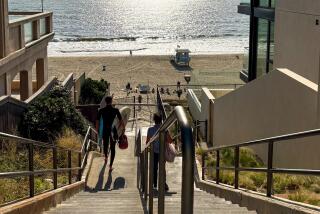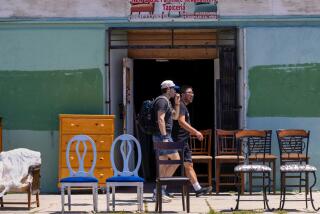The Longest Mile : Disabled Student Walks for Charity
IRVINE — Terri McHugh took a little walk Saturday morning, trudging a mile in a bit more than three hours. But her painfully slow stroll was as remarkable in its own way as a world-record marathon. McHugh, 28, is paralyzed from the chest down.
This Cal State Fullerton student isn’t about to let such factors stand in her way.
About 7 a.m., McHugh strapped on a pair of clear plastic leg braces and taped a dozen electrodes to her legs. Leaning with both hands on a lightweight walker outfitted with a device that shoots a mild bolt of electricity into her legs to fire off the muscles, she joined scores of able-bodied participants in the annual March of Dimes WalkAmerica event.
Like the rest, McHugh raised donations based on how far she would walk, collecting about $1,000 on her own for the charity.
Of course, most of the other walkers went a lot farther. All of them went faster. But then there’s the intangibles, things such as guts and willpower and being able to chuckle when you feel like crying.
It was no contest. McHugh outdistanced the rest by a mile.
Flanked by an entourage that included her therapists, family members and her boyfriend, the vivacious redhead took off down Harvard Avenue toward William R. Mason Regional Park, the finish line for the event’s 12-mile Irvine loop.
To take a step, McHugh would jab a small button on either handle of the walker, which is outfitted with a pair of wheels and decked with neon green and blue tape. The switch triggers a small computer and power pack, sending an electronic pulse shivering into her legs.
The electricity causes the muscles to react, and McHugh can swing her leg around, producing a slightly awkward, stiff-legged gait. But even a slow walk is better than no walk at all.
For that, McHugh can thank Dr. Jerrold Petrofsky and Janni Smith, co-founders of the Petrofsky Center for Rehabilitation and Research in Irvine, where the electronic system was developed.
Although the walking apparatus has been ballyhooed by the media as almost a miracle cure for paralysis, Petrofsky and Smith are quick to note the limitations of the system.
Its best use is as an aid for the disabled during occasional special events when they’d like to be able to stand and walk. The system has also proven effective for exercise, helping to prevent pressure sores, skin rashes and bladder infections that can afflict people who use wheelchairs.
“This isn’t something that allows people to just throw away their wheelchairs,” said Smith, who is also paralyzed from the waist down. “It’s slower, you’re more rigid. You can’t run in it.
“But it does have advantages,” she noted. “You’re up on your feet, seeing the world from a different perspective. From a psychological standpoint, that’s absolutely wonderful. There’s just something special about being able to get up and not only see someone eye-to-eye, but also to be able to dance in someone’s arms.”
Or more. Smith is something of a walking champion herself, having completed a 7-mile leg of the Honolulu Marathon in 1985 while helping develop the system. Back then, the computer and other hardware weighed 26 pounds. Today, Petrofsky has perfected a setup that’s the size of a pocket calculator.
“Some people can take three or four weeks to become beautiful walkers, others take a few months. It depends on their coordination and conditioning,” Petrofsky said.
Along with other participants from around the globe, McHugh spends several days each week at the Petrofsky clinic working out and perfecting her technique with the walking system. She has been using it for about two years, although she spends most of her time in her wheelchair while at home, school or work.
“It’s great,” McHugh said with a grin as she strode slowly along a bike path on Harvard Avenue. “I can get up and exercise, I can stand to get something off the top shelf of the fridge. I can find all my Christmas presents. It’s just nice to have the option.”
Until 1986, she had a typical life. She was raised in Anaheim, attending school at Canyon High. Then she fell asleep at the wheel of her sports car early one morning while driving down a rural highway in Northern California to visit her boyfriend, Stuart Stackhouse.
The car veered off the road, hit a stump and was crumpled. In the violence of the crash, McHugh’s spinal cord was snapped.
For the next few months, she spent time in a rehabilitation program, but ultimately went back to her job with Allstate Insurance in Sacramento and resumed living on her own.
When she heard about the Petrofsky clinic, McHugh was enticed by the idea of being able to walk again. She returned to Orange County to enter the program in 1988.
But before she took her first steps, McHugh had to go through extensive training to re-strengthen her sagging limbs.
“When Terri first came into the program, she was flabby, her legs had atrophied,” Petrofsky said. “Now she’s got a nice build, she’s very attractive, very healthy and she feels good.”
Out on the bike path, McHugh seemed in good spirits. When she stopped to adjust the leg braces, her boyfriend supported her from behind.
“You holding me?” McHugh inquired playfully.
“Nope,” Stackhouse quipped with a smile.
“I just gotta get better help,” McHugh deadpanned, pointing a thumb at Stackhouse.
As the steps mounted, McHugh began to fade in the midmorning heat. Her hands ached from leaning on the walker. Her body shivered with fatigue. McHugh was beginning to wish it was all over.
“Who’s got the money?” she asked, referring to the pledges she had collected for the benefit walk. “Bribe them to bring the finish line this way.”
Everyone grinned.
Soon enough, an arch of red, white and blue balloons at the finish line loomed. A crowd of onlookers began clapping and chanting, “Terri, Terri, Terri.” McHugh beamed as she broke through the tape.
McHugh was asked what she would be doing next.
Unable to resist the opening for a good punch line, she joked: “I’m going to Disneyland!”
More to Read
Sign up for Essential California
The most important California stories and recommendations in your inbox every morning.
You may occasionally receive promotional content from the Los Angeles Times.










